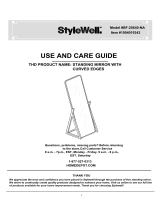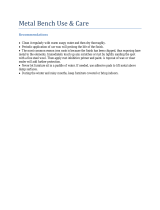Page is loading ...

e cleaners listed below can cause damage to the surface
of the melamine:
• Hydrochloric Acid Muriatic Acid
• Hydrogen Chloride
• Sulfuric Acid Oleic Acid
• Oleum
• Hydrouoric Acid Rust Remover
• Phosphoric Acid Rust Remover
• Sodium Hydroxide Caustic Soda
• Caustic
• Lye
• Soda Lye
• Pumice (abrasive)
Remember, sharp objects can damage the surface of the
shelving and the edge, marring its beauty and lowering
wear and stain resistance. Although faces are somewhat
resistant to scratch and marring, the face can be damaged,
even under normal use.
Dust cabinets frequently with a so lint-free cloth. You
can dampen the cloth slightly with water or spray-type
dust remover.
Clean spills immediately. Use a clean cloth and mild soap if
necessary. Wipe dry with a clean so cloth.
To clean the surface, use a damp cloth or sponge and a mild
soap and detergent. Dicult stains such as coee and tea
can be removed using a mild household cleaner and baking
soda; mixing to achieve a paste consistency. Use a sti
nylon bristle brush, scrubbing (approx. 15-20 strokes) the
aected area. Do not scrub so as to mar (damage, scratch)
the surface nish.
For at surfaces, stubborn stains that resist any of the
above cleaning methods may require the use of undiluted
household bleach or nail polish remover. Use a cotton ball
saturated with bleach or nail polish remover (acetone),
gently rub the stain for up to two minutes. Rinse
thoroughly with warm water and wipe dry using a so
cloth. Do not use these products on or near the edge for it
will damage the edge.
Acidic or abrasive cleaners can damage laminate surfaces;
do not use them. ese products can quickly damage the
PVC edge band as well. Drain cleaners containing lye will
permanently damage the laminate surface. If you spill a
drain cleaner, wipe it up immediately and rinse several
times with water. Hair, textile and food dyes can cause
permanent stains. If dye should happen to spill, wipe it up
immediately with dishwashing detergent or an all-purpose
cleaner. Wipe spills away promptly and rinse several times
with water. Rust removers contain harsh chemicals, which
will quickly cause permanent damage. If a spill occurs,
wipe o all residue immediately, wash thoroughly with
soapy water and rinse several times. Steel wool and other
abrasive pads will damage the melamine face. Do not use
them for cleaning and don’t store steel wool pads on your
shelving; the metal can rust and leave stains. Toilet bowl
cleaners contain harsh chemicals that can cause permanent
damage. If spills occur, wipe up immediately, wash surface
with soapy water and rinse several times.
CLEANING TIPS
CAUTIONS
DUSTING
SPILLS
CARE FOR MELAMINE SHELVING SURFACES
MELAMINE

We recommend that you do not mount heat-producing
appliances (such as coeemakers and toaster ovens)
beneath cabinets. Excess heat and moisture from these
appliances can damage cabinets.
Properly installed cabinets can safely support an evenly
distributed load of 15 pounds per square foot of shelf, tray
and drawer space, up to a maximum of 50 pounds. Be sure
that you load all cabinet bottoms, shelves, and trays evenly.
As with other natural materials, wood cabinetry will
gradually darken or mellow in response to aging, light and
UV exposure. Most likely, you’ll never notice this subtle
aging process unless, in a few years time, you compare your
cabinets to brand new ones.
Natural sunlight contains Ultra Violet (UV) light rays that
may aect the appearance of your cabinets. Wood species
and nishes have been tested so that you may be able to
determine the approximate eect that UV rays may have
on the cabinetry in your home. e tests used follow the
American Society of Testing Materials (ASTM) standards
for quartz ultra violet light (QUV). e actual results in
your home will vary depending on these three factors:
1. Exposure to light (for example, direct from the south,
east or west or indirect from the north.
2. e portion of the cabinet that receives the light (top,
base, etc.)
3. e wood itself. e nish does not change color, the
wood itself will.
With varying exposure to UV rays, and over time, color
variations will occur.
Be sure to clean up spills and any standing water (such as
condensation from a glass or bowl) immediately. Pay
special attention to the areas around your sink, range,
dishwasher, toe spaces and baseboards. Use a blotting
action rather than a wiping action. Be sure to apply
cleaning products directly to the clean cloth you are using.
Never apply directly to the surface of the melamine that
you are cleaning. Be sure to li objects – do not drag across
the surface. Be sure to avoid extreme in room humidity.
Too high or too low humidity can cause the wood to warp
or the glue used in applying the banding to fail. Be sure to
avoid extreme changes in room temperature. Be sure to use
pads, cloth or felt to protect surfaces from plastics, rubber,
hot dishes, beverages, bookends, owerpots and vases. Be
sure to use protective pads when writing with a ballpoint
pen. Be sure to make minor repairs while they are still
small. Be sure to treat your cabinetry as if it were
furniture. e cabinets are constructed with the same
laminates and wood as your furniture. ey require the
same care in order to reward you with long lasting beauty.
Do Not apply excessive weight or pull down excessively on
doors as this may cause them to split at the hinge area and sag.
Do Not place more than 100 pounds of weight into any
drawer as this may cause the bottom to sag or the drawer
guides to work improperly. Also, the weight of what is
stored in each drawer should be evenly distributed for the
best durability.
Do Not use petroleum distilled polishes on the surface of
your cabinetry, as they are oen ammable and toxic, and
they are seldom ever completely removed.
Do Not use concentrated detergents on your cabinetry.
Harsh detergents, strong soap and self-polishing waxes
could have a damaging eect on the nished surface.
Do Not leave damp or wet cloths draped over cabinet
doors. is moisture can cause permanent water damage to
the area over time.
Do Not wipe our cabinetry with a used dishcloth since it
could contain traces of grease or detergents.
Do Not place plastic or rubber objects on a wood nish –
their ingredients react with those of the nish.
Do Not place furniture in direct sunlight. Prolonged
exposure to direct sunlight may cause a change in color.
Do Not let water run o sink to countertops and
sink cabinetry.
Do Not expose the unbanded edges of cabinetry to
excessive moisture. Over time, prolonged wetness can
result in damage.
HEAT-PRODUCING APPLIANCES
LOADS & WEIGHT LIMITS
NATURAL AGING PROCESS
UV EFFECTS
GENERAL
© 2016 OrePac Building Products. All rights reserved. OP_0516
/







